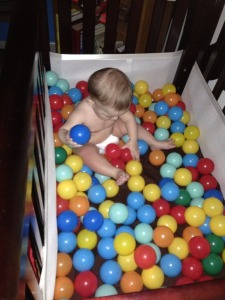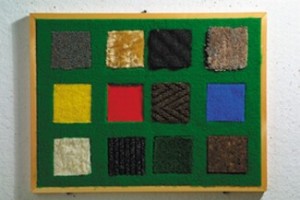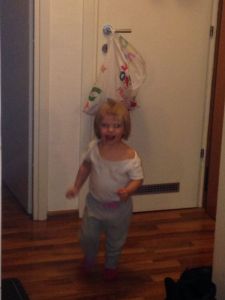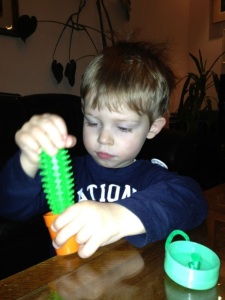Making the house sensory friendly
Are you among those lucky ones who have an empty basement which is not humid, perfectly convenient for a sensory room? I’m not! I live in an apartment. I do have a garage though, but it does not fit any of these criteria. It’s dirty, cluttered and humid. And it’s two floors down. Definitely not suitable for a sensory room. My parents have a basement, but it’s again humid, terribly cluttered and has a big freezer. Again, very unsuitable. Good news is, you don’t need a special room! One of the great things about sensory integration is that it makes you be very creative, it makes you think outside of the box. Children and parents I work with inspire me and are responsible for many of my ideas, games and tricks of the trade.
So, what can you do to make your small, often congested home sensory friendly? We should start thinking 3D! Use your wall, ceilings, floor, doors etc. Everything can be useful. First what you need to look at are your child’s needs and abilities. Are your child’s needs more proprioceptive, vestibular or perhaps visual? Having in mind all other senses, put a little extra of those your child needs the most. Also, please note that you don’t have to have these things in your living room the whole time and every day. You can change the setting as you wish, or per child’s needs. Have your child’s safety in mind at all times.
For proprioceptive:
- Lay mats of different thickness and softness onto the floor (information coming from the joints)
- Put some mats or safety sponges onto the walls (for children who like to run and bounce themselves off of the walls)
- Have Pilates kind of balls in the space (child can roll on the ball on their stomachs or you can lightly massage them with the ball on their backs or squeeze them in between two balls, or have them jump on the Pilates ball while catching some other small objects)
- Big cushions (take a duvet cover and fill it up with pillows, Styrofoam or small soft balls and have your child jump on it, cross over it, crawl on it, lay down on it etc.)
- fill up the crib with small plastic balls to make a DIY ball pit.

For tacticle:
- make tactile boards at home (they can be as simple as these squares below, or you can take it a higher level and make numbers and letters out of different materials, maybe even PECS cards in 3D!) and put them on the walls. If you have a bigger empty wall space, you can “dress” your wall into some fabric or some material.


- put different textiles, materials on the floor and keep your child barefoot if possible. You can have one corner of your room, or corner of your L-profile couch filled with cushions of different materials (soft, rough, spiky, woolen, furry, smooth) and a few cushions that look the same, but are of different weight and third category, same looking cushions filled differently – with beans, kitty sand (sterile), feathers, small stones, Styrofoam etc.)
- even coloring and writing can be fun (the green cactus is a pen and if you are as creative as this little guy, you may even use the pot to drink the sparkling water from)
- Bath time: does your child like the water? If yes, in a bath tub or sprayed on him/her as a shower? Strong pressure or mild? You can use shaving foam to play in the bath, put on child’s face and body, put on the swimming ducks – also incorporate other tactile stimuli here (put some sugar or grains of salt into the foam and spread on child’s body – better if they do it themselves, put some food coloring into the foam for visual stimulus, get some other toys that are spiky, rough, silky etc.)
- Oral: you can have your child wash their teeth and also brush the tongue, lips, gums around etc with a regular brush or for babies or from NUK. Also, use your fingers to massage the space around the mouth and cheeks. You can also massage child’s gums and tongue if they allow you. My newborn loves this along with a “wheels on the bus” song. Makes him smile a lot

For vestibular:
- implement a swing in your house (some parents had a net installed above their king sized beds and had a child climb on it and jump or drop down onto the mattresses – please consider safety here! – same you can do with a swing. Also, you can attach a swing on your ceiling and put a rope on a side so you don’t have to take the swing down each time, but just tuck it in between the rope and the wall or just keep it aside. IKEA has one or two nice swings that I use on daily basis. You can have your child be on the swing in different positions such as sitting, on their stomachs, on their knees or standing and implement different activities while swinging: catching some items that look the same, but are of different weight (proprioceptive) or material (tactile)
- you can have different objects that react when stepped on such as a balance board, or these balance pillows. Not only do they give some vestibular input, but they are spiky on their surfaces so play as a tactile input, too.
- one of the mothers I worked with flipped her couch upside down and used it as a slide for her daughter. I used big tight pillows down the couch for my niece and nephew
For visual:
- practically, all of the materials and equipment listed above as ideas for proprioceptive, vestibular and tactile come in some color and shape. If your child is sensitive to visual stimuli, keep it simple. Also, don’t get many reflector lights into the space. For those who are on a hypo side, you may have these things in different colors, shapes and sizes.
- get one of the colorful rotating reflectors
- if you implement the mats of different heights (and colors and textures) on your floor that I mentioned was good for the proprioceptive system, it is good for the visual, too.
Throughout the house: sometimes it is very hard to keep the kids sensory and otherwise happy when it is -30 degrees Celsius outside. Parks are not only unavailable due to the possible snow or cold, but at least here in Croatia it gets dark so fast (around 4pm) during the winter and for some unknown reason, parks are not equipped with the street lights. There’s something you can do indoors. Use your whole apartment or house, or at least a few rooms and a hallway, for this exercise: spread cushions, mats, tables, balance boards, balls etc. into a line of obstacles. If your child can follow instructions, you may give him a toy or a ball that they need to carry through the obstacles and put into a basket in the end (have some kind of a goal – may it be as simple as a kiss to mom). Some parts they should crawl on, crawl under, crawl through, some walk over, some jump through and so on. Here’s a visual:









Put your creative hat on and have fun!




